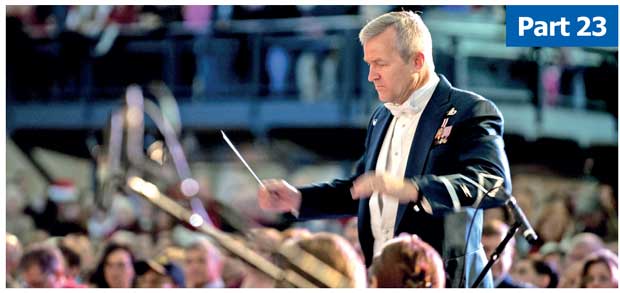Reply To:
Name - Reply Comment
Last Updated : 2024-04-20 20:10:00

 Not only do the great teammates allow different leaders to consistently emerge based on their strengths, but also, they realize that leadership can and should be situational, depending on the needs of the team. Sometimes a teammate needs a warm hug. Sometimes the team needs a visionary, a new style of directive, someone to lead the way or even, on occasion, a kick in the back.
Not only do the great teammates allow different leaders to consistently emerge based on their strengths, but also, they realize that leadership can and should be situational, depending on the needs of the team. Sometimes a teammate needs a warm hug. Sometimes the team needs a visionary, a new style of directive, someone to lead the way or even, on occasion, a kick in the back.
For that reason, great leaders choose their leadership style like a golfer chooses his or her club, with a calculated analysis of the matter at hand, the end goal and the best tool for the job.
Here are the four leadership styles experts have uncovered among the quality leaders, as well as a brief analysis of the effects of each style on the corporate climate:
Visionary leader
The visionary leader expects excellence and self-direction. If this style were summed up in one phrase, it would be, “Do as I do, now.” The visionary style works best when the team is already motivated and skilled and the leader needs quick results. Used extensively, however, this style can overwhelm team members and squelch innovation.
Directive leader
The directive leader mobilizes the team toward a common vision and focuses on end goals, leaving the means up to each individual. If this style were summed up in one phrase, it would be “Come with me.” This directive style works best when the team needs a new leadership because the circumstances have changed or when explicit guidance is not required. Directive leaders inspire an entrepreneurial spirit and vibrant enthusiasm for the mission.
Affiliative leader
The affiliative leader works to create emotional bonds that bring a feeling of bonding and belonging to the organisation. If this style were summed up in one phrase, it would be, “People come first.” The affiliative style works best in times of stress, when teammates need to heal from a trauma or when the team needs to rebuild trust.
Democratic leader
The democratic leader builds consensus through participation. If this style were summed up in one phrase, it would be, “What do you think?” The democratic style is most effective when the leader needs the team to buy into or have ownership of a decision, plan or goal or if he or she is uncertain and needs fresh ideas from qualified teammates.
From the brief descriptions above you probably already have a good idea of which styles work well in certain situations. A highly directive style, for instance, works well in crisis situations and in times when the stakes are high. In those circumstances, it’s important that orders are precisely followed so that the issue can be resolved in an effective manner.
It can also be a good style to use when working with very inexperienced staff who need direction on how project activities should be done. If this style is overused however, it can have a damaging effect, as it doesn’t value and recognise individual contributions.
Exercise
For an exercise, let’s turn our attention to the initial stages of a project and the leadership styles that would prove most effective.
Imagine that you are a project leader and that you are in the process of pulling together a team for a new project. In most cases, you will probably use a blend of individual conversations and team meetings as you address people.
In order to understand which leadership styles are most effective during this stage, when the team is being formed, try to see the situation from the individual’s point of view. The team member is thinking: what is this project all about? What is in it for me? Which skills will I be able to develop? Who are the other team members? What will my role be, etc.?
As a leader, the best you can do in this situation is to provide clarity, structure and inspire the team to contribute to the project’s ultimate objectives. You can do that by using the visionary style.
Depending on how experienced – or not – the team is, you will also have to make use of your directive leadership style early on in the project. The greener the team is, the more explicit you need to be about what you expect and how you expect it to be done.
Many project leaders assume that their teams know how to work together and are therefore not directive enough in the beginning. Don’t make that mistake. Make it clear what you expect from each role and lay down the ground rules. It is likely that you need be more directive at the beginning of the project than at any other point.
Relatively soon after the team has formed, it moves into a storming phase where positions, roles and objectives are challenged. Some members may feel overwhelmed by how much there is to do or they are uncomfortable with the approach or the objectives.
During this phase, you should make use of your listening, mediating and conflict-resolution skills – in order words – the affiliative leadership style. Your role at this point is to make people feel safe, address their concerns and build relationships between people. The focus is on building trust and planning collaboratively so that the team can concentrate on the actual objectives instead becoming distracted by emotional issues.
At this point, it can also be good to be more democratic in your style, as you need to build consensus and encourage the team to work together. Don’t use the democratic style all the time as that would mean renouncing your leadership role. Use it where the process of building consensus is more important than the outcome itself – for instance in agreeing how you will be tracking progress and which team meetings the project will have.
In these circumstances, it can be an advantage to take a facilitative role and hand over decision-making to the team.
Gradually, as the structure of the team is established and roles and responsibilities are accepted, the team progresses into, what is known as the normalising stage. Team members come to respect one another and start to bond. Decisions are made in agreement and some start to show ownership and take responsibility.
Your role in this phase is to support and guide the team and to encourage collaboration. Be mindful of each person’s talents and needs and gradually take a step back as individuals start to engage and take responsibility. What this means is that your need to be directive style.
If you find that the team isn’t performing as well as you had hoped, you can act as a visionary to increase performance. Roll your sleeves up and show how you would like things to be done. But be careful not to overuse this style as it can easily discourage the members of your team.
The next natural progression is when your team reaches the performing stage. Here the team is strategically aware and knows clearly why it is doing what it is doing. It works towards a common goal, has a high degree of autonomy and is able to stand on its own feet with little interference.
In this phase, you have delegated entire roles and work streams and observe the team from the side-line. You continue to inspire, support and challenge the team to think in creative and innovative ways, meaning that you predominately make use of the visionary and directive styles. The directive and affiliative styles should still be used as required – especially during times of crisis and conflict – but hopefully the need will be minimal.
At no point should you become an absent leader, as your inspiration, support and insightful questions will always be needed.
(Lionel Wijesiri is a retired corporate director counting three decades of senior management experience. He is now an independent consultant and a freelance journalist. He may be contacted on lionwije@live.com)

Add comment
Comments will be edited (grammar, spelling and slang) and authorized at the discretion of Daily Mirror online. The website also has the right not to publish selected comments.
Reply To:
Name - Reply Comment
On March 26, a couple arriving from Thailand was arrested with 88 live animal
According to villagers from Naula-Moragolla out of 105 families 80 can afford
Is the situation in Sri Lanka so grim that locals harbour hope that they coul
A recent post on social media revealed that three purple-faced langurs near t